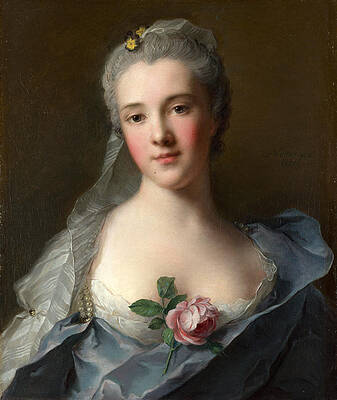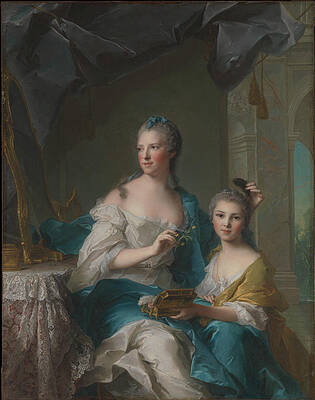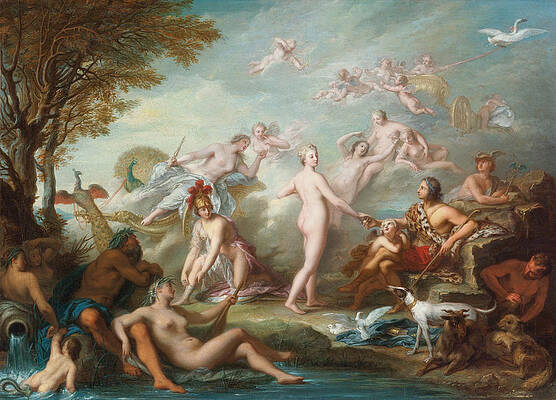Jean-Marc Nattier
Paintings
Manon Balletti
Portrait der Victoire de France
The Spring
Madame de Maison-Rouge as Diana
Princess Isabella of Parma
Madame Sophie
Portrait der Victoire de France
Marie Adelaide of France as Flora
A Reclining Lady as the Penitent Magdalene
Portrait of a Woman as Diana
Madame Marsollier and Her Daughter
Portrait of Eleonore Louise Le Gendre de Berville, Marquise du Hallay-Coetquen
Thalia, Muse of Comedy
Marie Francoise de La Cropte de St. Abre, Marquise d'Argence
Justice punishing Injustice called Madame Adelaide as Justice
The Judgment of Paris


Portrait of Queen Mary Leczinska




The Duchesse de Chaulnes Represented as Hebe




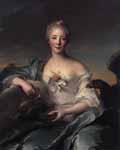
Madame Le Fčvre de Caumartin as Hebe

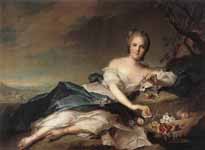
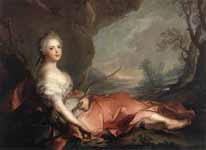
Marie Adelaide of France as Diana

Madame Marsollier and her Daughter


Portrait of Louis XV of France
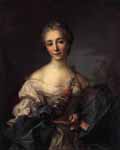



Portrait of a Young Woman Painter
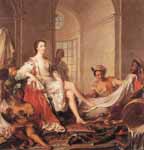
Mademoiselle de Clermont "en Sultane"

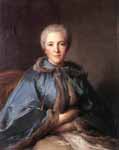
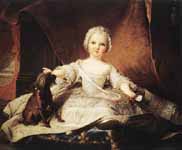
Portrait of Madame Maria Zeffirina
Fine Art Prints | Greeting Cards | Phone Cases | Lifestyle | Face Masks | Men's , Women' Apparel | Home Decor | jigsaw puzzles | Notebooks | Tapestries | ...
Jean-Marc Nattier (March 17, 1685 – November 7, 1766), French painter, was born in Paris, the second son of Marc Nattier (1642–1705), a portrait painter, and of Marie Courtois (1655–1703), a miniaturist. He is noted for his portraits of the ladies of King Louis XV's court in classical mythological attire.
Jean-Marc Nattier, Louis Tocque
Life
He received his first instruction from his father, and from his uncle, the history painter Jean Jouvenet (1644–1717). He enrolled in the Royal Academy in 1703 and made a series of drawing of the Marie de Médicis painting cycle by Peter Paul Rubens in the Luxembourg Palace; the publication (1710) of engravings based on these drawings made Nattier famous. He had applied himself to copying pictures at the Luxembourg Gallery, he refused to proceed to the French Academy in Rome, though he had taken the first prize at the Paris Academy at the age of fifteen. In 1715 he went to Amsterdam, where Peter the Great was then staying, and painted portraits of the tsar and the empress Catherine, but declined an offer to go to Russia.[1]
Nattier aspired to be a history painter. Between 1715 and 1720 he devoted himself to compositions like the "Battle of Pultawa", which he painted for Peter the Great, and the "Petrification of Phineus and of his Companions", which led to his election to the Academy.
Portraits
Jean-Marc Nattier - Portrait of Madame Marie-Henriette Berthelot de Pléneuf
The financial collapse of 1720 caused by the schemes of Law all but ruined Nattier, who found himself forced to devote his whole energy to portraiture, which was more lucrative. He became the painter of the artificial ladies of Louis XV's court. He subsequently revived the genre of the allegorical portrait, in which a living person is depicted as a Greco-Roman goddess or other mythological figure. [1]
Nattier's graceful and charming portraits of court ladies in this mode were very fashionable, partly because he could beautify a sitter while also retaining her likeness. The most notable examples of his straightforward portraiture are the "Marie Leczinska" at the Dijon Museum, and a group of the artist surrounded by his family,"The Artist Surrounded by His Family", dated 1730. He died in Paris in 1766.[1]
Many of his pictures are in the public collections of France. Thus at the Louvre is his "Magdalen"; at Nantes the portrait of "La Camargo" and "A Lady of the Court of Louis XV". At Orléans a "Head of a Young Girl", at Marseilles a portrait of "Mme de Pompadour", at Perpignan a portrait of Louis XV, and at Valenciennes a portrait of "Le Duc de Boufflers". The Versailles Museum owns an important group of two ladies, and the Dresden Gallery a portrait of the "Maréchal de Saxe". At the Wallace collection Nattier is represented by "The comtesse de Tillières" (formerly known as "Portrait of a Lady in Blue"), "Mademoiselle de Clermont en sultane", and "The marquise de Belestat". In the early part of the 20th century in the collection of Mr Lionel Phillips were the duchess of Flavacourt as "Le Silence", and the duchess of Châteauroux as "Le Point du jour" (now at Marseilles). A portrait of the Comtesse de Neubourg and her Daughter formed part of the Vaile Collection, and realized 4500 guineas at the sale of this collection in 1903. Nattier's works have been engraved by Alphonse Leroy, Tardieu, Jean Audran (1667–1756), Dupin and many other noted craftsmen. The Getty Museum has "Madame Bonier de la Mosson as Diana", 1742. The Metropolitan Museum of Art has "Madame de Maison-Rouge as Diana", 1756.[1]
Sources
Nattier: Jean-Marc Nattier Masters in Art: A Series of Illustrated Monographs: Issued Monthly; June, 1902, Part 30, Vol. 3, (Bates & Guild Co., Boston)
References
Chisholm 1911.
This article incorporates text from a publication now in the public domain: Chisholm, Hugh, ed. (1911). "Nattier, Jean Marc". Encyclopædia Britannica (11th ed.). Cambridge University Press.; Endnotes:
See "J. M. Nattier", by Paul Mantz, in the Gazette des beaux-arts (1894)
Life of Nattier, by his daughter, Madame Tocqué
Nattier by Pierre de Nolhac (1904, revised 1910)
French Painters of the XVIIIth Century, by Lady Dilke (London, 1899).
----
Fine Art Prints | Greeting Cards | Phone Cases | Lifestyle | Face Masks | Men's , Women' Apparel | Home Decor | jigsaw puzzles | Notebooks | Tapestries | ...
----
Artist
A - B - C - D - E - F - G - H - I - J - K - L - M -
N - O - P - Q - R - S - T - U - V - W - X - Y - Z
Retrieved from "http://en.wikipedia.org/"
All text is available under the terms of the GNU Free Documentation License


